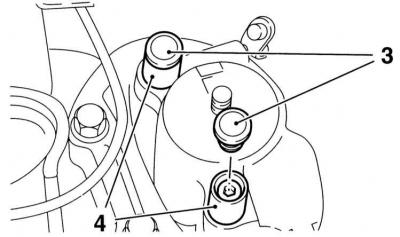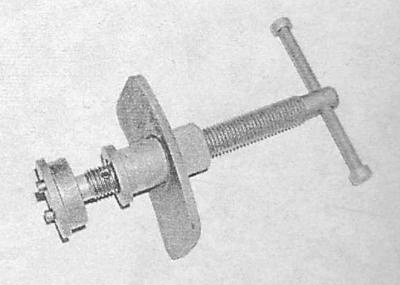To prevent the vehicle from pulling to the side during braking, the brake pads must be replaced on both front/rear brakes at the same time. Remember that the dust generated during the operation of the brake mechanisms may contain asbestos, which is extremely harmful to human health. Never blow off dust with compressed air or inhale it - wear a protective mask or respirator when servicing mechanisms. Never use gasoline or petroleum-based solvents to clean brake system components - use only branded cleaners or methyl alcohol!
1. Apply the parking brake, jack up the front of the vehicle and place it on jack stands. Remove the front wheels.
2. Using a small slotted screwdriver, remove the pad wear sensor from the hole in the caliper (1) and take him aside.

3. Remove the large spring clip from the caliper - be careful not to jump off the spring, cover it with a rag before prying it with a screwdriver.
A - Removing the fixing spring from the front brake caliper on Astra models
B - Removing the fixing spring from the front brake caliper on Zafira models
A.

B.

4. Remove dustproof caps of openings of directing fingers of a support.

5. Turn out the guide bolts and remove the caliper with pads from the anchor bracket or hub carriage (depending on the execution method). Tie the caliper to the rack with a piece of wire - do not leave it hanging on the hose.
6. Remove the outer pad from the caliper, then remove the inner pad held by a metal spring attached to its base.

1 - Inner block
2 - Outer block
7. Sweep away dust accumulated on the surfaces of the brake components (see the warning at the beginning). Wipe the caliper and piston face with a clean rag. Remove rust from the edge of the brake disc.
8. Measure the thickness of each pad, not including the metal backing. If any pad is damaged or worn beyond the allowable limit (see Specifications), replace the entire set of pads, both front wheels. Oily pads must be replaced without fail - first eliminate the cause of the development of the leak. When the pad wear indicator comes into contact with the disc (indicator lamp on the instrument panel), it should also be replaced.
9. If the condition of the brake pads is found satisfactory, carefully clean them of dirt with a soft wire brush, paying special attention to the back and sides. Clean the grooves in the friction linings, completely removing foreign inclusions from them. Clean the pad seats in the caliper and anchor bracket.
10. The guide pins should move easily in the caliper bushings. Lubricate the backs of the pads with copper grease. Check the condition of the anther installed on the piston, inspect the piston for signs of brake fluid leakage, corrosion and mechanical damage. Make necessary repairs if necessary (see Removal, refurbishment and installation of front wheel disc brake calipers). Replace defective components.
11. When installing new pads, the piston must be sunk into the caliper cylinder in order to release it for installing thicker new pads. The piston is pressed using a special Vauxhall tool, although a suitable clamp or wooden lever will work just as effectively. If the GTZ reservoir is not filled to the top, squeezing the piston should not cause brake fluid to leak out of it, however, it would be wise to check its level first - if necessary, pump out the excess.
A - Special tool for pressing the brake caliper piston
B - Pushing the piston with an adjustable clamp
A.

B.

Depressing the piston carries the risk of damaging the sealing collar! The compilers of this Guide recommend pinching the brake hose with a clamp and bleed the fluid through the bleeder fitting, after releasing it half a turn.
12. Fill the caliper with the inner brake shoe, seating its spring in the recess in the end surface of the piston.

The inner and outer pads differ from each other in design - pay attention to the marking in the form of an arrow applied to the base of the pad - the arrow should point in the direction of rotation of the disk when the car is moving forward.
13. Install the outer pad on the caliper, friction lining to the disc, the pad is equipped with an acoustic signal spring (1), warning the driver of pad wear.

14. Install the floating clevis with the inner shoe over the outer shoe and lay it on the bracket.
15. Screw in bolts of directing plugs and tighten them with the demanded effort.
16. Install the anthers.
17. Install the caliper spring by inserting its ends into the holes in the bracket.
Two types of springs are used - one is connected to the caliper, the other to the mounts on the outer shoe. If the last type of spring is installed, first connect it to the shoe, then slide it over the tabs on the caliper.
18. Reinstall the pad wear sensor.
19. Squeeze the foot brake pedal several times until you feel a firm movement.
20. In the same manner, replace the brake pads on the opposite wheel.
21. Install the wheels, lower the vehicle to the ground and tighten the wheel bolts to specification.
22. Check the brake fluid level, correct if necessary (see chapter Current service).

Visitor comments